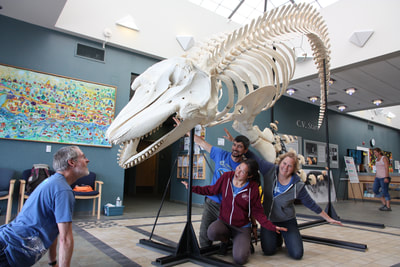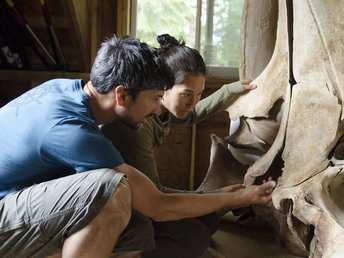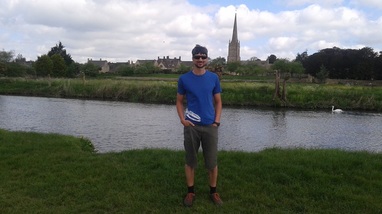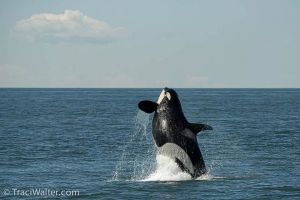|
This summer, we helped run a month-long community based orca project down in Fort Bragg, California, with Lee (the Boneman) Post of Homer, Alaska, and Sheila Semans of the Noyo Center. Over the four weeks, we put our tools in the hands of a fabulous team of student interns, local volunteers and the Noyo crew. Our workshop was hopping with skeleton articulation stations, a scientific illustration class, artist displays, evening panel discussions and ongoing marine technology demos. It was all open to the public and summer camp students so we had a continuous stream of curious on-lookers and questions askers. With a little magic happening in Mike's metal-shop, and a whole lot of collaboration, we created one of the most beautiful and dynamic orca skeleton mounts that we've seen (see our exhibits page for some photos of the finished skeleton.)
0 Comments
The blue whale skeleton at the London Natural History Museum has finally been moved from the museum's whale hall, where she hung for decades gathering dust. The skeleton has been cleaned up, disarticulated, restored, moved and re-articulated in a dramatic downward lunge-feeding posture after years of planning. Mike went over to London last Spring and again in the winter to help the articulator team with planning the design of the exhibit and then to work with George on the fabrication of the armature that supports the skeleton's massive skull and lower jawbones. She's now impressively mounted with an elegant internal and external steel armature and suspended from stainless cables from the ceiling of Hintze Hall, the museum's main entrance area.
The sea otter skeleton that we enjoyed working on through this winter in our basement has finally returned home to Calvert Island and is now suspended in the main lodge of the Hakai Research Institute. Check out this great article recently published in Smithsonian Magazine about this project and a little more on the way we make a living.
People are always captivated by the work we do. To be honest, we're captivated too, it is incredibly interesting. I have to admit though that I often avoid answering the "and what do you do for work?" question if I know that I have limited time. "Oh, you know, a little of this and that..."
Invariably, after the initial question, we can expect a puzzled if not bewildered look. And the conversation that follows from the "and what does that mean exactly?" question will be followed again and again by all kinds of "you actually do that? And someone pays you for that? How in the world did you get into that?..." Recently, Glen Schaefer from the Vancouver Sun came over here because he wanted to see for himself what we do and I think he captured the essence of it pretty well. So I thought I'd share the article and video he produced for any of you who might also be wondering what on earth we've been up to over here... Check out "It's a whale of a dirty job, but somebody's got to do it." Mike has just returned from a preliminary consulting trip to London, England. In 2017, Cetacea Contracting will be part of the team that has been hired to re-articulate the 100-year old blue whale skeleton at the London Natural History Museum! Conservators have been working for over a year to clean and prepare the bones. Once the skeleton is ready, Mike and George Hudson will be helping the internationally renowned team from RCI (Research Casting International) to design and fabricate a new custom armature that will see the skeleton brought to life in Hintze Hall, the main gallery space of the museum.
Last week, Mike was asked to visit the Shaw Ocean Discovery Centre in Sidney, BC, to help bring life to the skeleton of A9 which had been on display at the aquarium but wasn't creating as much of a stir as a skeleton such as hers should have. Together with a group of core volunteers from the aquarium, A9 was moved, her flippers were re-articulated for anatomical accuracy then repositioned along with her skull. An interpretive dorsal fin and tail fluke were also fabricated to complete the display. Now, as visitors walk through the aquarium, A9 swims toward them as she would have moved in life.
Earlier this month, a young adult male transient killer whale named L95 was found floating offshore near Tahsis and was towed into harbour. With amazing support from the town of Tahsis and funding from the Royal Ontario Museum, we were able to recover his skeleton. A necropsy was conducted but cause of death remains unknown. Once transported to our island, our keen volunteer, Ashley, came over for the morning to help prepare the whale's remains for composting burial. The ROM has contributed one of his teeth for a new Fisheries study on methods to accurately age killer whales and his skeleton is destined for display in a planned future exhibit at the museum.
This was a fun little winter project for Mike. He designed a custom wheeled skull dolly to transport and protect the humpback skull that we had collected for the Royal BC Museum from Whitepine Cove, Tofino, in 2014. It's now safely accessioned at the RBCM. (Yes, that's the workshop we're building - it's coming along!)
On Dec 4, 2015, southern resident J32 (Rhapsody) was found on a beach near Comox, BC. She was pregnant with a full-term foetus and initial observations indicate she may have died of infection. The death of J32 is a huge loss to the struggling SRKW population and especially tragic to lose this first-born calf as well. We collected the remains of her skeleton and that of her calf on behalf of the Royal BC Museum and with huge backing from the local community. These skeletons will be held at the Royal BC Museum and will be available for future research and education.
This fall we were asked by the Beaty Museum to come back and have a close look at the massive blue whale skeleton we had prepared, articulated and installed five years ago (see our blue whale page for more about that project.) Along with Jesse, our handiest friend around who also shares no fear of heights, we had the honour of being back in close contact with big blue for a week. Aside from a thin layer of dust that we brushed and vacuumed off her bones, we found relatively little wear to touch up. There were a few hairline cracks, which we believe resulted from heating and cooling in the all-glass atrium. All in all, we were extremely pleased with how this amazing specimen has aged. Many other shared our excitement to have another close look at the skeleton, check out this article by Brian Hutchinson.
|
Posted by:
Michi Main Archives
September 2017
Categories
|




















 RSS Feed
RSS Feed
